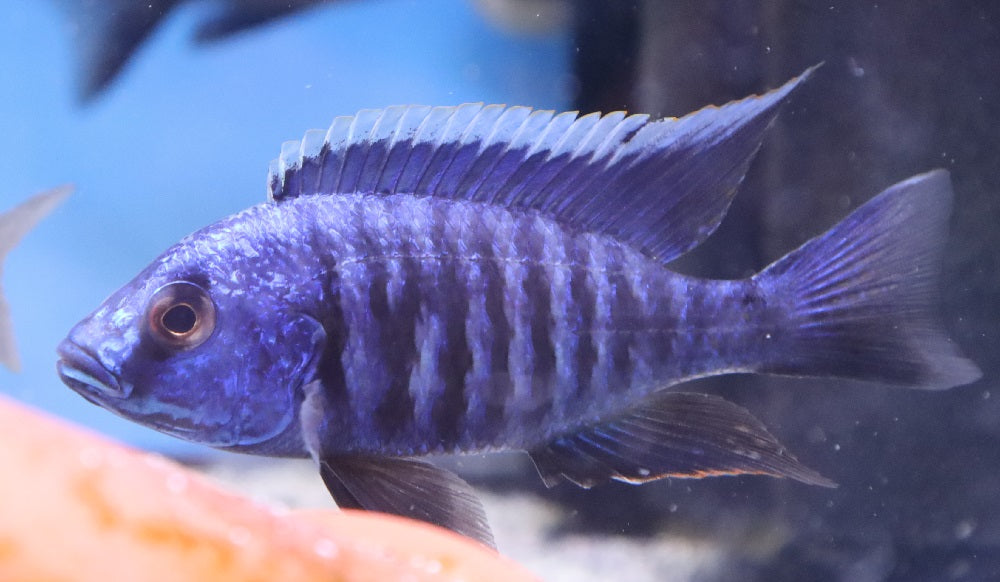



Azureus Cichlid
Copadichromis Azureus Cichlid
The Blue Azureus Cichlid, scientifically referred to as Cichlasoma azureus, has remarkable visual characteristics. Its most prominent feature is its azure pigmentation, which immediately grabs attention due to its distinct and vibrant color properties.

Blue Azureus Cichlid for Sale
Captive bred Azureus Cichlids for sale guaranteed exceptional quality, boasting a healthy and vibrant stock, carefully nurtured to exhibit the coveted azure coloration with stunning blue hues.
Scientific Name: Copadichromis Azureus
Common Name(s): Azureus
Family: Haplochromine (Hap)
Origin: Undu Reef, Lake Malawi, Tanzania, Africa
Captive Bred or Wild: Captive Bred
Temperament: Aggressive
Tank Habitat: Rocky tank with plenty of open swimming space and caves
Maximum Size: 7 inch / 18 cm
Water Temperature: 74-82° F (23-28° C)
Water pH: 7.5-8.4
Water Hardness: Hard
Diet: Omnivore / Flake or pellet / Blood worms, Snails or Brine Shrimp (Live or Frozen)
Breeding: Maternal Mouthbrooder

Azureus Cichlid Size
Azureus Cichlids, a freshwater fish species belonging to the Cichlidae family, exhibits varying sizes across different life growing stages.
Azureus juvenile and fry Azureus Cichlids span from approximately 1/4 inch to around 1 1/2 inches. As these juveniles progress into the growing adult phase, their dimensions advance to a range of 2 to 3 inches.
Upon reaching maturity, Azureus Cichlids attain their maximum size, which can range from 5 to 6 inches on average, with the potential to achieve a fully grown size of up to 7 inches.
Azureus Cichlid Tank Mates
Tank Mate Compatibility: African Malawi Peacocks, African Malawi Haps, African Victorian Haps
Azureus Tank Size
Cichlid Tanks
Azureus Cichlids exhibit a vibrant and dynamic nature, thriving in environments that offer ample room for their active swimming behavior.
Azureus fish particularly appreciate the presence of river rocks, reefs, and assorted tank decorations along with a suitable substrate. To ensure optimal well-being and happiness for these cichlids, it is strongly advised to opt for a tank capacity of at least 55 gallons.
For those seeking to accommodate an Azureus variant and facilitate its full adult growth, the recommended tank capacity expands to a range of 60 to 120 gallons. Within this spacious setting, a Azureus Cichlid can flourish and attain a maximum size of around 7 inches.
To explore our curated selection of recommended Cichlid tanks tailored to these specific needs, kindly refer to the provided link below.

Azureus Male
The male Azureus Cichlid is a striking and captivating freshwater fish and is known for its vibrant blue azure coloration, distinct physical features, and interesting behaviors.
Male Azureus Cichlids showcase a visually stunning appearance, with their vibrant hues and intricate patterns. Their body is typically adorned with shades of blue, turquoise, and green, often displaying a metallic sheen that sparkles under proper lighting.
They have elongated dorsal and anal fins, adding to their unique and eye-catching profile.
In their natural habitat and within aquarium settings, male Azureus Cichlids exhibit a territorial and hierarchical behavior. They establish and defend territories, especially during breeding periods, and engage in various displays to attract and court females while asserting their dominance over rival males. These behaviors include fin flaring, color enhancement, and ritualistic swimming patterns.
Male Azureus Cichlids are known for their involvement in the intricate process of reproduction. They invest significant effort in preparing and defending nesting sites, often hollowing out crevices within rocks or creating pits in the substrate. Once a suitable mate is courted and selected, the female deposits her eggs within the nesting site, after which the male fertilizes them. The male diligently guards and tends to the nest, protecting the eggs and later the fry. This paternal care continues even after the fry have hatched, showcasing the male's commitment to their offspring's survival.
Male Azureus Cichlids tend to be slightly larger than females, with an average size ranging from 5 to 7 inches in length. Their growth rate can be influenced by factors such as water quality, diet, and tank conditions.

Azureus Female
The female Azureus Cichlid exhibits a smaller physical stature in comparison to its male counterpart, adorned with distinctive shades of silver and grey. Upon reaching maturity, an adult female Azureus Cichlid commonly measures within the range of 5 to 6 inches.
Azureus Male vs Female
In the dynamic realm of Azureus Cichlids, the male assumes a position of dominance and, consequently, influences the tank's prevailing environment. A notable divergence emerges in their size, with males achieving larger dimensions while females maintain a slightly smaller profile.
Azureus Cichlid Juveniles
The trajectory of Azureus Cichlids from juvenile to adulthood is a compelling narrative of growth. This journey commences as they transition from the fry stage, evolving in size and form.
Azureus juveniles typically span from 1 to 2 inches in length during this phase. Notably, some early vestiges of coloring can be discerned, particularly in males.
Azureus Fry
The reproductive cycle of the female Azureus culminates in the production of a significant clutch of eggs, numbering up to 30 or potentially more. These eggs undergo a transformation, metamorphosing into Azureus fry that commence their journey at a mere 3/8 of an inch in size. This pivotal stage marks the inception of new life within the Azureus Cichlid realm, perpetuating the species with each diminutive emergence.
Shipping and Handling FAQ
- VERY IMPORTANT SHIPPING INFORMATION -
-

Shipping Companies
All purchases will be shipped using UPS next day air for next day shipments to ensure no dead fish on arrival.
-

Live Guarantee
We guarantee the cichlid ordered will be safe during shipping and will arrive alive and well. Be sure to follow the shipping after care instructions included in your shipment.
-

Processing Time
All orders will have a processing time to ensure the cichlid fish ordered can safely travel during shipping. Each fish's safety is our #1 priority, The typical processing time is 48 hours.
-

Shipping Days
Orders are shipping Monday through Thursdays. Orders placed Monday will be shipped the following Thursday, and order placed after Monday will be shipping on the following Monday.
Shipping After Care
Azureus Care & Food
Azureus Shipping After Care
The proper acclimation of the fish requires time and patience to prevent any shock after shipment. Place the fish in their plastic bags in the aquarium, Float the bag(s) in the aquarium water for 30 to 60 minutes to acclimate the tank water with the bag water. When complete remove the bag(s) from the tank and pour the fish into a net then safely place the fish into your aquarium.
Azureus General Care
The best care for Azureus is maintaining proper nutrition and water quality, having the right tank size, and providing plenty of rocky hiding spots.
Azureus Food
Omnivore / Flake or pellet / Blood worms, Snails or Brine Shrimp (Live or Frozen)
#1 Cichlid Food Pellet recommend by our Master Breeder - Buy on Amazon
Popular African Peacock Cichlids
-
Blue Dragon Blood Peacock Cichlid
Regular price From $19.98Regular priceUnit price per$0.00Sale price From $19.98 -
OB Peacock Cichlid
Regular price From $24.98Regular priceUnit price per$0.00Sale price From $24.98 -
 Sale
SaleLemon Jake Cichlid
Regular price From $24.98Regular priceUnit price per$59.99Sale price From $24.98Sale -
Strawberry Peacock Cichlid
Regular price From $19.98Regular priceUnit price per$59.98Sale price From $19.98Sale
















